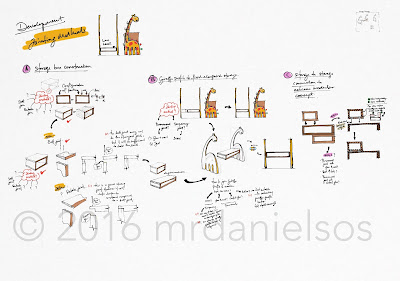Updated on 2nd August 2016
This post is an extension and a supplement to "Coursework Experiential Journal Component 2016 Example" that was originally created as a guide and reference material for my Secondary 3NA student mini coursework. I will not repeat information I have already posted previously.
What you'll see in this post are pictorial/visual examples on Ideas Generation and Development (and refinements) in a design journal. The examples do not represent any complete section of a journal. They serve as a starting point - an example - a demonstration - a suggestion - a recommendation - etc. to show what sort of contents may go into, say development, and how you can present your research and information in the journal.
Use them as a reference and a guide to start or to improve your journal. Make informed choices on your own on what your takeaways should be after looking at the materials in here. Do not copy.
If you find this helpful, I would love to hear from you. If you have suggestions, please do not hesitate to link up with me.
----------------------------------------------------------------------------------------------------
Idea Generation / Ideation
Use of photos and images are starter and triggers for more ideas. In this case images of animals. Design Brief is about a storage solution that will appeal to children, that will motivate them to keep their toys.
----------------------------------------------------------------------------------------------------
Development / Refinement (Using SCAMPER)
Refining Shape & Form of a selected idea / concept. Some suggested ways that may help you start the process. Interestingly I use S.C.A.M.P.E.R. for this. Now you know S.C.A.M.P.E.R. need not be used only for ideation, but a great tool for development too.
---------------------------------------------------------------------------------------------------
Development / Refinement
Refining Jointing Methods on the various parts of the selected idea / concept. Some suggested ways that may help you start the process.
A quick summary on the decisions made for refinement of shapes & forms is quickly drawn at the top of the page. Three areas are then identified that require decision on the most suitable type of jointing methods.
The page above shows examples on how options for different types of joints can be presented in the journal.
It's always a good practice to summarise all of your decisions every sections. (Above) To have a clearer overview of what I have done so far about jointing methods for the whole product, I consolidate decisions about the types of jointing methods selected for the various parts and draw them as a complete product..
---------------------------------------------------------------------------------------------------
Development / Refinement
Refining Overall Size and Proportions based on Anthropometric Data and Critical Dimensions.
To develop the storage size and dimensions , the product height, overall size and other detailed sizing of the other parts of the product, I identified and made a list on the areas that I need to decide on. Then proceed to work out each of one of them using researched Anthropometric data as well as Critical dimensions.
---------------------------------------------------------------------------------------------------
Development / Refinement
Stay tuned for : materials, etc...
---------------------------------------------------------------------------------------------------










